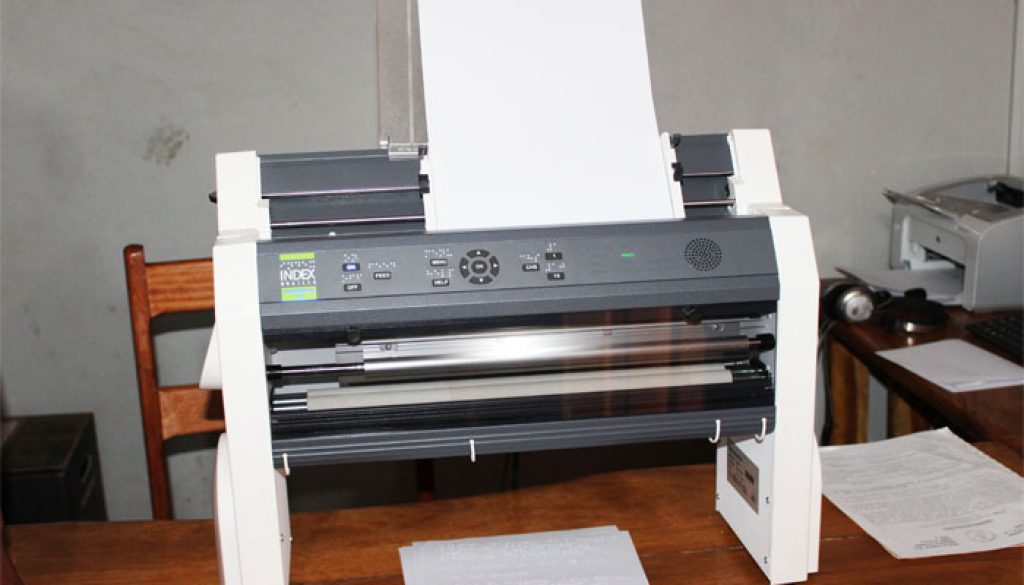Braille Embossers, Breakthrough for Learners with Visual Impairment
Braille is a system of raised dots that can be read with the fingers by people with visual impairment. The Cameroon Baptist Convention (CBC) Health Services in a partnership deal with the Swedish Index Braille company, now supplies braille embossers (printers) in Cameroon and Central African Sub Region to improve education for persons with visual impairment.
A braille embosser is an impact printer that renders text as tactile braille cells. Using braille translation software, a document can be embossed with relative ease, making braille production efficient and cost-effective.
CBC Health Services stands to be a leading organization in empowering the Social and Economic life of persons with disabilities in Cameroon.
Education for the visually impaired in Africa and Cameroon in particular is hampered by lots of challenges such as lack of assistive technologies like the index braille that does mass printing of the braille. More so, students with visual impairment are often left behind during classes and examinations because of the additional time it takes to type and translate the braille language before assessment.
Perkins Braille typewriter that use to be used takes more time.
Mr. Awa Jacque Chirac, Coordinator of the Services for Persons with Disabilities (SPD) at the CBC Health Services told us that the Cameroon General Examination (GCE) Board for several years has been facing difficulties to effectively manage examinations for persons with visual impairment in the country.
“Due to the lack of the appropriate technology, the board at first was using the Perkins Braille-the braille typewriter, which type the braille manually and uses more time. With this regard, we took it upon ourselves to introduce the Everest D-Embosser braille printer which is faster and cost-effective.
In 2016 we supplied 7 copies of braille embossers to the University of Bamenda, the Teachers Resource Center in Bamenda and other institutions in Cameroon. Unfortunately, there was no individual in Cameroon with the expertise to manage these embossers. We decided to train personnel and move forward to signing a partnership deal with Swedish firm Index Braille, to supply the Everest D-Embosser braille printer to institutions in Cameroon.
Mr. Chirac says Everest D-Embosser braille printer is the best quality and most used braille printers in the world. He added that those who buy braille from SPD of the CBC Health Services benefit from free training on how to use the braille embosser.
However, the braille embosser works with computer assistive programs such as Duxbury Braille Translator, that translate scanned documents to braille and other languages for embossing (printing).
Madame Fondop Anne has 11years experience translating and typing braille in Lycee Classic and CISPAM in the West Region of Cameroon. She was happy to tell us about her experience. “Students with visual impairment are always left behind due to extra time and cost it takes to manually type and translate their papers before assessment.
Fondop Anne told us that the embosser is a big rescue to learners with impairment in the West Region.
With the coming of the embossers, mass printing of braille can be done, and students with visual impairment can now write their exams the same time with sighted students, unlike before when their examination use to take a longer period of time for printing and translation.
This process of manually typing and translating has kept the fate of many visually impaired students in the hands of the translators, since a bad or wicked translator may interpret the student wrongly. This can be costly to the student’s result,” regrets Madame Fondop.
“The braille printer is effective and gives just what the student wrote. Students can also type and translate their papers themselves.
It takes about 45mins to manually type a page of braille language with the Perkins Braille, but the embosser prints a page in less than 2minutes
“Many teachers don’t have the patience to follow up the visually impaired in class because their learning process requires more time, especially when they do not understand braille. A visually impaired student needs to stumble between 6 dots before writing a letter, unlike a sighted student who sees what he or she is writing.
The visually impaired student will need to joggle between six dots to write a letter
Fondop Anne is passionate in braille translation and typing; she says braille teachers are very few in Cameroon, and only the passionate ones will settle for the pay package.
The Services for Persons with Disabilities of the CBC Health Services now stands as the sole supplier of Braille Printers in Cameroon and Central Africa. This effort is in a bit to provide quality and inclusive education for persons with disabilities.
Everest-D Embosser (Advantages)
Horizontal and Vertical Printing:
As in any printer, the standard print horizontally on the page to create a portrait style format. However, because of a concept called floating Dot page (or Area) a number of print types and Braille output features have been more easily achievable on Index embossers because we are able to place Braille dots anywhere on the page and still maintain double-sided Braille. This method is flexible and no other braille embossers offer it currently.
Floating Page:
A floating dot area is a user-defined area on a page that is composed of a set of braille dots. The floating dot area can either define an entire page or it can define a part of a page which can be interspersed among ordinary braille text.
When embossing traditional double-sided braille, the floating Dot page automatically creates the braille dots between on another one both sides of the page so that no two dots merg
